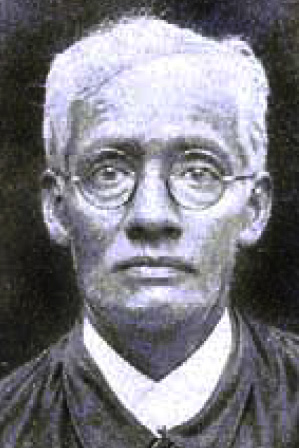Gopal Chandra Praharaj
Died :- 16-May-1945
Place of Birth :-

Gopal Chandra Prahraj, a linguist, poet, storyteller, story-based feature writer of eminence, writer of children's literature, critic, and author of the immortal work ‘Purnachandra Bhashakosh’ which is a monumental multi-lingual Odia dictionary – monumental in the history of Oriya language – was born on September 9, 1874 in Siddheswarpur of Cuttack district. His father was Narasimha Prahraj. One Kinei Acharya, an ancestor of Gopal Prahraj, had shifted to this village from the Birgobindpur saasan in Puri district as a representative of a zamindar living in Ayodhya. Over time, he acquired the zamindar’s land by virtue of his intellect and hard work. His successors received titles like Chowdhury, Rayaguru, Padushi, Samantaraya and Praharaj on the basis of their socio-political roles. In that sense, it is possible Gopal Prahraj belonged to the fifth generation of Kinei Acharya.
Praharaj's personal life has been the subject matter of many controversies. His father opened a minor school in the village. He studied there until the 4th grade and enrolled in the 5th grade at the Ravenshaw Collegiate School. The parents wanted the boy – eldest among brothers and sisters – to become a highly placed officer after higher education. However, after getting through the Entrance in 1891 and the FA in the Ravenshaw in 1894, Praharaj got a BL degree from Calcutta in 1902 at the age of 28 and started practicing law in Cuttack. He later received the titles of Kaiser-e-Hind and Raybahadur from the British government in 1933.
Praharaj’s family life was turbulent and controversial. They were seven brothers and eight sisters. After his father's death in 1914, he failed to keep his family together as the eldest member of the family. Leaving his ancestral home, he built a house for himself at the end of the village. At the age of eighteen, Prahraj married the eight-year-old illiterate Muktamani of Santh village near Sakshigopal and brought her home along with his young and widowed sister-in-law Pitambari. During his stay in Cuttack, Pitambari went there and stayed with him. It created an issue between him and his wife. Prahraj’s life is also like a tragic drama. His wife died following an attack by unknown assailants. And, almost in a similar way, Praharaj met his end after taking poisonous food served to him following a conspiracy.
Prahraj has left his immortal imprints in all fields of literature, including poetry, storytelling, feature writing, essays, literary criticism, language discussion, magazine editing, biography, and autobiography. His literary journey began with poetry. The first one was ‘Matrusmruti’ written in memory of his mother. Two rhyme books for children – Dho’re Baya Dho' and ‘Baai Dasanka Bjajan O Sishu Geeta’ were his published works on children’s literature. His first published book was ‘Utkalara Kahani’. This is a collection of eight folk stories. He later wrote ‘Jejebaapanka Kahani’ based on history and legends, for textbook purpose. Prevalent Odia banters and proverbs have been published in two parts under the title ‘Odia Loukika Pada baa Dhaga Dhamali’.
Praharaj’s autobiography is famous for its confessional contents, and is one of the most unique biographies in Odia literature. Some important pages containing controversies were destroyed by his relatives.
Praharaj’s discussions on literature and social issues include, ‘Two Pieces of Oriya Books’, ‘Vishuddha Bhasha’, ‘Utkal Sahityara Adhunik Gati’, ‘Bargya Ba’, ‘Nakshatra’, ‘Odia Bhashara Keteka Bibhrat’, ‘Bartaman Jugare Sanskruta Sikshara Upajogita’, ‘Saraswata Rajyare Hitlerism’, etc. He edited two magazines — the Satya Samachar weekly and the Prajamitra, semi-weekly.
Through his satirical features Prahraj sincerely tried to attack and remove social evils while also trying to expose the inherent flaws in human character in society. His story-based feature books are: ‘Bhagabata Tungire Sandhya’, ‘Bai Mahanty Panji’, ‘Mian Sahebanka Roznamcha’, ‘Duniyaar Halchal’, ‘Nanaanka Bastani’, ‘Aama Gharara Haalchaal’, ‘Baainaninka Bujuli’, ‘Dhaaratabandhaara Punjipaanthi’, ‘Jeje Baapanka Tunimuni’ and ‘Duniyaar Reeti Ae’. It is learnt that no titles other than ‘Bhagabata Tungire Sandhya’ and ‘Bai Mahanty Panji’ were published during the lifetime of the author.
‘Purna Chandra Odia Bhashakosh’, is a true reflection of his personality, which he completed after 27 years of painstaking effort. It is a timeless expression of the self-esteem and literary mindset of the Odia nation. It is true that he has suffered a lot in various ways during this hard pursuit, but, no doubt, he has enjoyed this sufferance like being in the practice of Raj Yoga. It was a ‘Raj Yoga in dreams’ for him as he has mentioned in an article under the same title.
Books
Audio story
Copyright © 2024 Odia Virtual Academy. All rights reserved Total Visitors- 1
Powered by: Odia Virtual Academy

